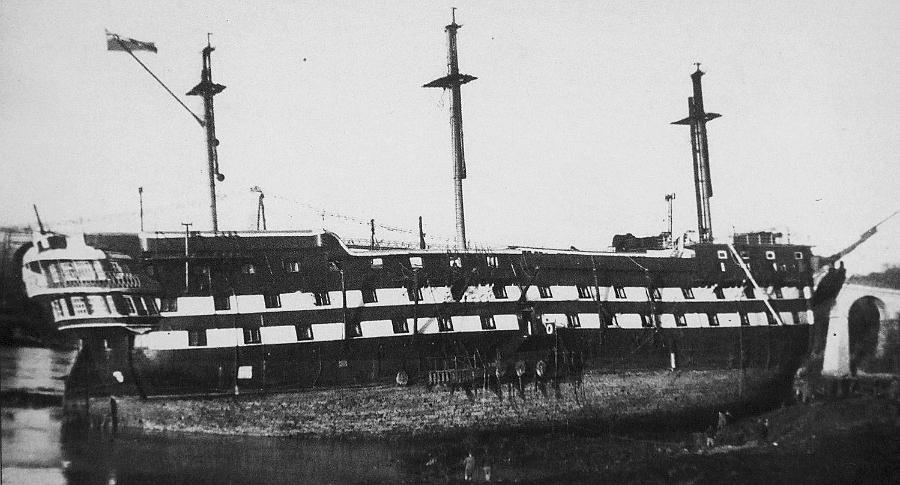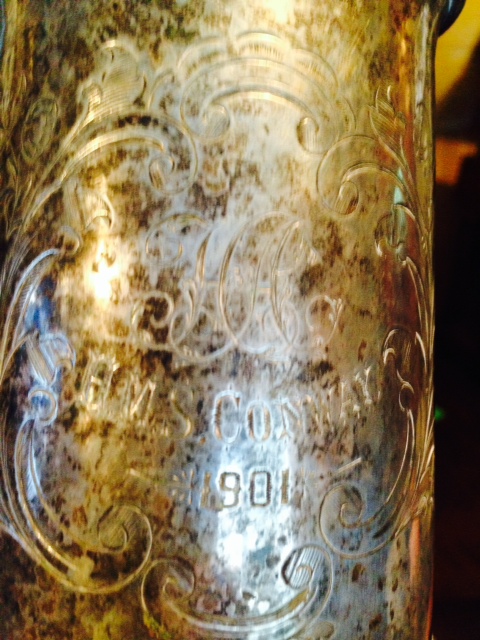images of HMS Conway, both on the Mersey & Menai Straits
First narration written by © Alfie Windsor
1998 (Reprinted with permission)
In
the mid 1800s the British merchant fleet had many shortcomings. The
Merchant Shipping Acts of 1851 and 1854 were designed to force
improvements and control. They required all deep sea vessels to be
commanded and officered by experienced, certified individuals who were
to sit examinations. Those making a career at sea now had to be
trained and educated in academic as well as nautical subjects. The
merchant fleet owners, fearing further legislation and government
intervention, determined to take the initiative. Ship owners in
various main ports of the UK formed Mercantile Marine Service
Associations (MMSA). Liverpool was one of the earliest and in 1857
they decided to set up a school ship specifically to train young boys
for a life at sea. After much debate they petitioned the Admiralty for
a ship to accommodate the school which was to be moored in the Sloyne,
off Rock Ferry, on the River Mersey in Liverpool, England. The mooring
was approximately a quarter mile ESE of the river end of Rock Ferry
Pier. After examining a number of vessels (they very nearly chose HMS
Vestal) they accepted a small Jackass Frigate named HMS Conway.
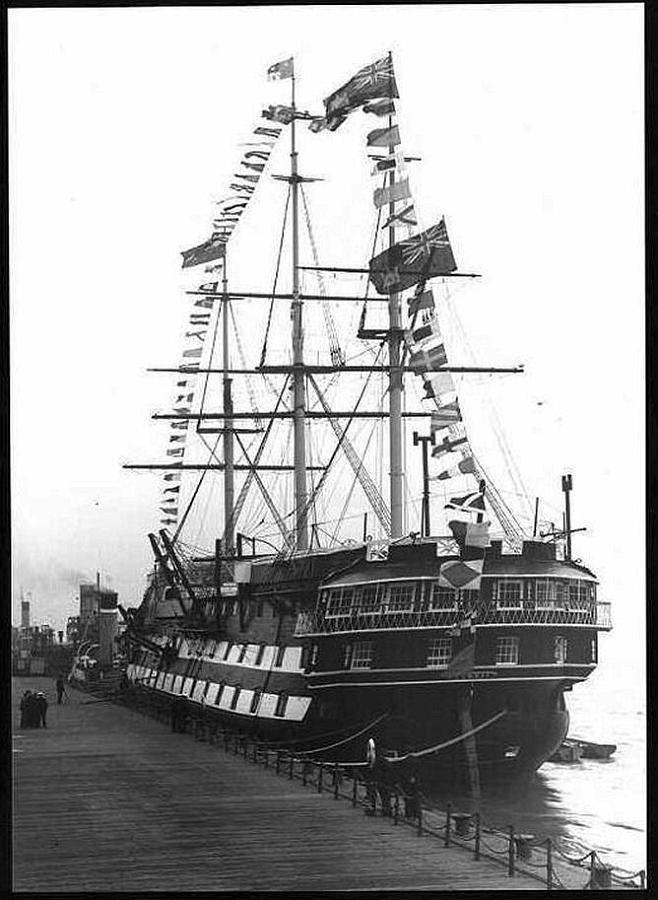
HMS Conway 1859 - 1974
© Alfie Windsor 1998
The Mersey Years 1859 - 1941
| 5
Feb 1859 |
Towed
by the Virago from Devonport to the Mersey. |
| 9
Feb 1859 |
Arrived on her mooring in the Mersey. This was off Rock Ferry
Pier (between Rock Ferry and New Ferry). The pier and landing
stage at Rock Ferry was built in 1899 and in the same year
Birkenhead Corporation operated the ferry service at Rock
Ferry and New Ferry. The ferry service at Rock Ferry closed in
1939.
|
| 1
Aug 1859 |
The
very first cadet to join the ship was Captain Howard Campbell.
He was cadet number 8, but actually arrived on board before
cadet number 1: Captain Berkeley Collins. |
|
17 Aug 1859 |
Official
opening of the HMS Conway school ship, interestingly the band
of HMS Nile played at the opening ceremony as the Nile was in
Liverpool at the time on a recruiting visit.
The ship was fitted to accommodate 120 cadets but opened with
just 17.
Numbers
were limited to 50 for the first six months. Average numbers
of cadets built up to around a hundred. Initially many cadets
stayed for only a couple of terms - getting the feel of naval
life.
It was
quickly realized that the ship was too small for the numbers
eventually planned. The Admiralty was petitioned again and
offered to replace the first HMS Conway with a new vessel -
HMS Winchester.
|
|
Nov 1861 |
The
Admiralty decided to loan HMS Winchester to the Liverpool MMSA
as a replacement for the original ship which was not large
enough to accommodate the cadets. The two ships exchanged
names so HMS Winchester became the second HMS Conway. |
|
1861 |
In the
1850s, in order to qualify as a merchant navy officer a four
year apprenticeship had to be served at sea. The Liverpool
shipping company of Jones, Palmer & Co and others had, at the
opening of the school, announced that two or three years on
the Conway would be accepted by them as the equivalent of one
year at sea, reducing their apprenticeship time. In 1861 the
Board Of Trade decided formally that two years spent training
at Conway would count as one year served as a cadet at sea.
Thus Conway cadets only had to complete three years training
at sea instead of the four required for anyone going straight
to sea. For this reason Cadets in their last term were called
Quarter Boys or QBs. This practice continued for over 100
years until closure in 1974. Cadets received a Conway Passing
Out Certificate of Exemption when they left Conway. |
| 4
Feb 1864 |
Queen
Victoria announces the award of annual prizes to cadets to the
value of £50, and the instigation of a Queen's Gold Medal. |
|
Jun 1866 |
HRH The
Duke Of Edinburgh presented the prizes. |
|
24 July 1876 |
The second
ship (ex Winchester) also proved too small and so the
Admiralty were approached and they offerred a third ship - HMS
Nile as a replacement. The date of her arrival in the Mersey
is not clear. Conway 2 (ex Winchester) was taken away to
Devonport early in July retaining the HMS Conway name for the
time being . The officers and cadets relocated to the Nile.
Permission
was eventually granted for the name change from HMS Nile to
HMS Conway and on 24th July 1876 Nile was moved to the Great
Float (the West Float) Liverpool and formally exchanged names
with the second HMS Conway - the school ship's third vessel to
bear the name.
After the
ceremony she returned to her mooring off Rock Ferry Pier,
Cadets lived onboard but used sports facilities ashore. Rock
Ferry playing fields were on Knowlsey Road off New Chester
Road. They have now been built over.
The
cooking ranges from the Great Eastern, Brunel's famous ship
which had been broken up nearby, were installed in the Conway.
|
|
1877 |
Cadets
manned the yards when the Shah Of Persia sailed up the Mersey
to visit Liverpool. |
| 8
Sep 1881 |
Cadets
provided a guard of honour for HRH the Prince Of Wales , his
wife, Princess Alexandra and their children on their visit to
Liverpool to open the new Alexandra Dock |
|
1882-4 |
A
number of vessels were moored in line astern in the Sloyne:
HMS Defence the Liverpool guardship, HMS Conway, the Akbar
(Protestant reformatory ship), Indefatigable and the Clarence
(Roman Catholic reformatory ship burnt twice by her boys and
replaced!). |
|
1886 |
116
cadets formed a guard of honour for the visit of Queen
Victoria to the Liverpool Exhibition. |
|
16 May 1889 |
First
edition of The Cadet magazine produced. |
|
26 April 1891 |
A cadet
was lost overboard, the first since opening. |
|
28 Feb 1895 |
The
Mersey was frozen from shore to shore. |
|
17 Dec 1895 |
The
ship was docked in Bilston Graving Dock for an overhaul. All
her copper was removed. She was scraped, recaulked, refelted
and recoppered. Ten tons of copper were used. She was
repainted. |
|
28 Jan 1896 |
Returned to her mooring. |
|
19 Jul 1899 |
Duke Of
York, later King George V attends and presents the King's Gold
medal to Cadet Jackson. This was presented to and displayed in
Sydney Cathedral, Australia but was stolen in 2000. The King
encouraged the cadets to "truthfulness, obedience and zeal". |
|
1890 |
First
Conway - Worcester boat race. They won. |
|
1901-02 |
Mr H B
Steel, Lancashire County Cricket player began to coach the
cricket team. |
|
19 Jul 1904 |
141
cadets formed a guard of honour at Liverpool Town Hall for the
visit of King Edward VII to lay the foundation stone for
Liverpool Cathedral. The King presented the King's Gold Medal
in person. |
|
1904 |
Six
acres of grounds were bought for playing fields. |
| 3
Jun 1905 |
3
cadets saved a man from attempted suicide in the River Mersey. |
|
1905 |
The
ship's two 10 oared cutters were found to be beyond repair and
were cremated in the ship's furnace. Two new 12 oared cutters
made of teak in Bombay Dockyard were provided. |
|
1906 |
The
Conway - Worcester boat race was discontinued. |
|
19/20 Jan 1907 |
SS
Arbutus dragged her moorings and collided with the ship,
breaking upper gangway and smashing a cutter to bits. |
|
Mar 1907 |
A cadet
left after serving 5 years - the longest stay on record! |
|
Jan 1909 |
The
band was formed when the piping of orders was replaced by more
audible bugle calls. |
|
Jul 1910 |
Old
Boys Association formed and renamed the Conway Club on
December 13th. |
|
1912 |
Preparation introduced two evenings a week, with cadet
captains taking charge. |
|
11 Jul 1913 |
HM the
King whilst visiting Liverpool went aboard the Mauretania (the
wood paneling from her first class dining room is in a wine
bar at the foot of Park Street in Bristol). 100 cadets formed
a guard of honour on board the liner. The King presented the
Gold Medal in person. |
|
1914-1918 |
Depot
Ship Devonport. |
|
Feb 1914 |
Conway
House was opened as a sick bay on the eastern end of the
playing fields. |
|
Jan/Feb 1917 |
The
river was almost completely frozen over. The cadets could get
out of the Pinnace in the middle of the river and walk about.
An instructor fell overboard and died. |
|
Dec 1917 |
Cadets
were granted permission to enroll as Cadets RNR and wear
regulation Naval uniform. The same privilege was accorded to
Worcester and Pangbourne cadets. The traditional uniform was
given up with some regret. |
| 4
Jun 1918 |
The
figurehead, a bust of Lord Horatio Nelson was carried away by
the SS Bhamo in a collision with the ship that also carried
away the jib-boom. A shortened jib-boom was installed but the
figurehead was not replaced for another twenty years.
|
|
Jul 1924 |
HM the
King presented the King's Gold Medal in person at the Town
Hall. |
|
1925 |
The
1905 'Bombay' cutters were replaced by a pair of matched
fifteen hundredweight, 27 feet ten oared cutters specially
built for the ship. |
|
15 May 1925 |
Miss K
Mayo and Miss M Moyca Newell, the founders of the New York
Apprentices Club visited the ship. |
|
19 Jul 1927 |
100
cadets were inspected by HM the King at Liverpool Town Hall.
The King presented the King's Gold Medal in person. |
| 4
Nov 1931 |
The
Price Of Wales (later King Edward VIII) visited the ship and
presented the King's Gold Medal. Cadets formed a Guard Of
Honour on the pier when the Prince re-embarked for Liverpool. |
|
18 July 1934 |
King
George V visited Liverpool to open the new road tunnel. He
presented the King's Gold Medal to Cadet H Kirby and spoke to
Commander M G Douglas. Acting Captain at the time. The King
and Queen then went on to open Birkenhead Library where the
majority of the cadets paraded. Finally The King and Queen
left from Rock Ferry Station where a guard of 30 cadets was
posted. |
|
Sept 1934 |
'TomÕ
Browne was appointed as Headmaster as a result of the shipÕs
first Board Of Education inspection. There had not been a head
for some years and his mission from the Management Committee
was to raise academic standards. This was not to prove easy as
many cadets considered 'schoolÕ behind them and had little
inclination to academic studies. He stayed for 30 years and
made a huge impact. He established a small scince lab on the
upper deck, a Library, a gym in the hold, re-arranged the
timetable and introduced prep twice a week. The times they
were aÕchangin. |
|
April 1935 |
Air
Training was introduced with the theory of flight, airmanship
taught on board and 15 hours flying at Hooton Aerodrome. This
was sufficient for Cadets to obtain their 'A' private pilot's
licence. By the end of the summer term the first cadets had
obtained their pilot's licences! |
|
1937 |
There was a common entrance exam in 1937.
In 1937 it was decided that the ship should have a new
figurehead to replace the original one (a bust of Lord Horatio
Nelson) which had been carried away on 4 June 1918 by the SS
Bhamo. A design consisting of a full figure of Lord Horatio
Nelson was chosen. The design and construction were undertaken
by Mr. Carter Pearson. He took great pains to ensure
authenticity, studying Nelson's actual uniform to match
colours and various portraits, including Nelson's death mask,
to obtain a true likeness. The figurehead was made from teak
as this was considered a more long lasting wood than the
yellow pine normally used for ships' figureheads. A sound
decision as the figurehead still survives although now at HMS
Nelson in Porstmouth (the RN's Courts Martial Centre!). It was
not possible to obtain a single block of wood large enough so
3 inch planks were used. It weighs 3.5 tons and stands 13.5
feet high.
|
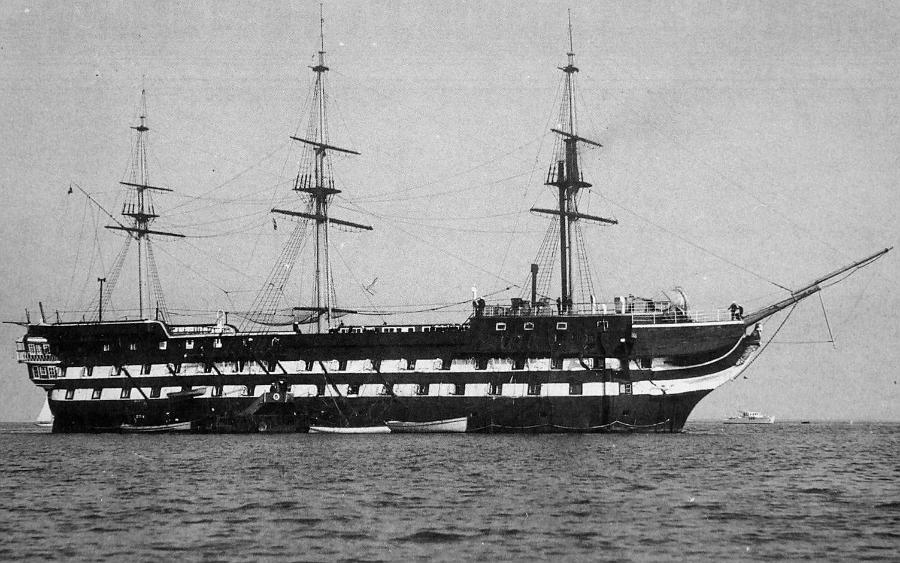
| 1938 |
Heating and
hot water was provided from a coal fired boiler. Hot water was
limited to the galley and a weekly bath. If you were a senior
it was hot. Coaling party (punishment) had to be second or
third user of bath by then usually tepid. New chums cleaned
the grime line in the baths. The heating pipes never seemed to
be more than warm. Heads were really primitive until the 1938
refit. The galley was also improved in this refit and
converted to coke fired. Food was also greatly improved.
Teaser was freely wielded. What the politically correct would
think now I leave to your imagination.
The ship
was moved to Cammell Lairds shipyard, Liverpool for a refit
under the sponsorship of Mr L Holt and Alfred Holt & Co. The
work was undertaken by Mr Dickie. The total cost was £20,000.
|
|
11 Sept. 1938 |
Alongside Liverpool
Pierhead Landing Stage for the masting of the new figurehead
by John Masefield OM the Poet Laureate. |
| 1939 |
We used the Chart House for seamanship
lessons, but not frequently. A cadet whilst descending to the
deck via the backstay fell on the roof, and was fatally
injured some time in the early war years I believe. It was
said a broken wire strand pierced his hand and he lost his
hold.
In my time
there was no nursery table for new chums or any tables on that
deck and the Port and Starboard fo'csles had their hammocks
stowed in their parts of ship in what from memory we called
hammock nettings. No hammocks were stowed in the hold, but
there was a stowage in the hold for our gladstone
bags and fresh laundry bags were used for pillows viewing
cinema in the hold.
|
|
2 May 1939 |
A celebratory dinner was
held at Liverpool Town Hall, hosted by the Lord Mayor. |
|
Pre World War 2 |
A cutter race took place
in London's Royal Docks between Conway, Worcester and General
Boths crews. Much to the surprise of the South African
organizer it was won by Worcester who still hold the trophy
because it was never raced for again. |
|
Sep 1939 |
Indefatigable cadets came aboard during
the summer holidays. They painted out the ships white gun
strakes, painted the upper deck battleship gray, fitted
concrete bomb protectors to all hatches and skylights, covered
the upper deck with sand bags and fitted black out screens to
all 130 windows.
The 12 oared cutter, also called the
heavy weather cutter was used when the Mersey was too rough
for the motor boats.
|
|
Oct 1940 |
Considerable damage was caused to the
ship by the SS Hektoria, a 13,000 ton whaling factory ship
which had dragged her moorings. Conway was moved into Vittoria
Dock, Birkenhead for repairs where, at start of the next term,
the cadets all rejoined ship.
There were, at this time, 250 cadets
and problems arose. The ConwayÕs sewage disposal was direct
from the ship into the river, or dock, where she was moored.
To discharge sewage into a fast tidal river was one thing but
to discharge the effluent from 250+ people into a dock with no
tidal flow is another. Cadets were sent home early!
It has been said that there was no
heating in the ship but there was a primitive form of piped
hot water central heating. Indeed, such was my executive
promise that in my 6th term I became the Working Hand in
charge of the Boiler; a position of great power with
possibilities for profit. Apart from stoking the thing I could
toast (bake, actually) slices of bread by resting them on the
inside of the fire door, closing it for a moment, and then
opening again - to reveal a golden brown piece of toast
(usually smudged with coal dust, but no matter) I charged one
old penny per slice! It sys much for the system that I
progressed quite rapidly to the higher echelons after that
term!
|
|
1941 |
During the Liverpool blitz the
situation became extremely unsafe, particularly when the
Germans began dropping parachute mines into the Mersey. Small
incendiary bombs landed on the ship most nights - the cadets
scooped them up with shovels and tossed them into the river!
Bombing became more intense and one night a mine was thought
to have settled under the ship. The cadets were evacuated
ashore and spent the night in Conway House (Sick Bay), the
Royal Mersey Yacht Club and Royal Rock Hotel. They then spent
two nights at the Mostyn School before being sent home.
Two nights later two mines narrowly
missed the ship, one exploded under and sank a nearby vessel,
the S.S. Tacoma City. The only people on board the ship were
Capt. Goddard, Lt John Brooke Smith, No.1 motor boat's crew,
and a steward. Lt Brooke Smith took away No.1 motor boat (Jim
Thompson was bowman) and they picked up everyone from the
Tacoma City (45 survivors in total). They then proceeded down
the river where larger craft which had come off from shore
took the survivors off them. The second magnetic mine drifted
well up river where it was exploded by a minesweeper after the
ship had been completely evacuated.
It was decided to move the ship to a
safer anchorage on the Menai Straits.
|
|
8 Mar 1941 |
The ship left Vittoria
Dock and, on 9 March, returned to her mooring in the Sloyne by
0945 hours. |
|
May 21 / 22 1941 |
Moved (under tow by the
Langworth and Dongarth) to Glyn Garth Mooring on the Menai
Straits, Anglesey. |
The above text is written by Alfie
Windsor in 1998 and can be found on
www.hmsconway.org
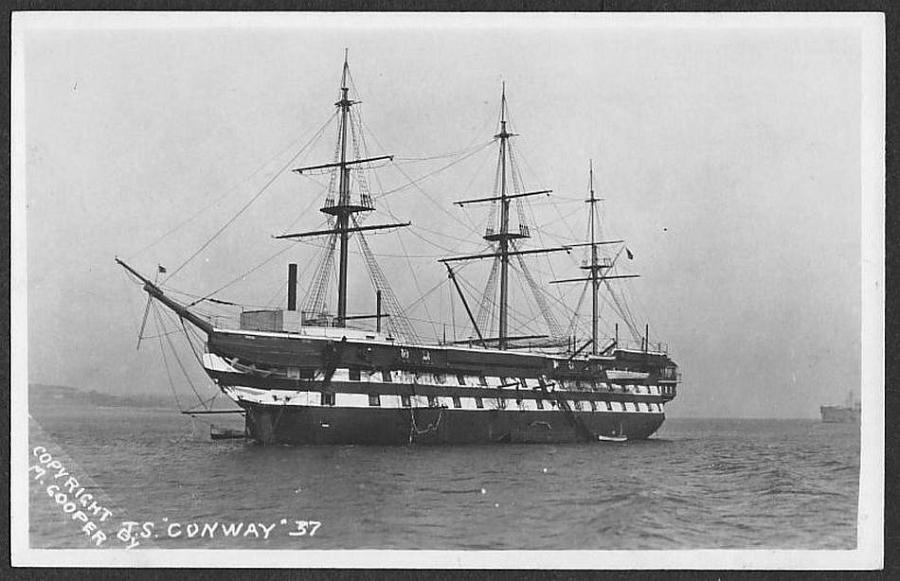
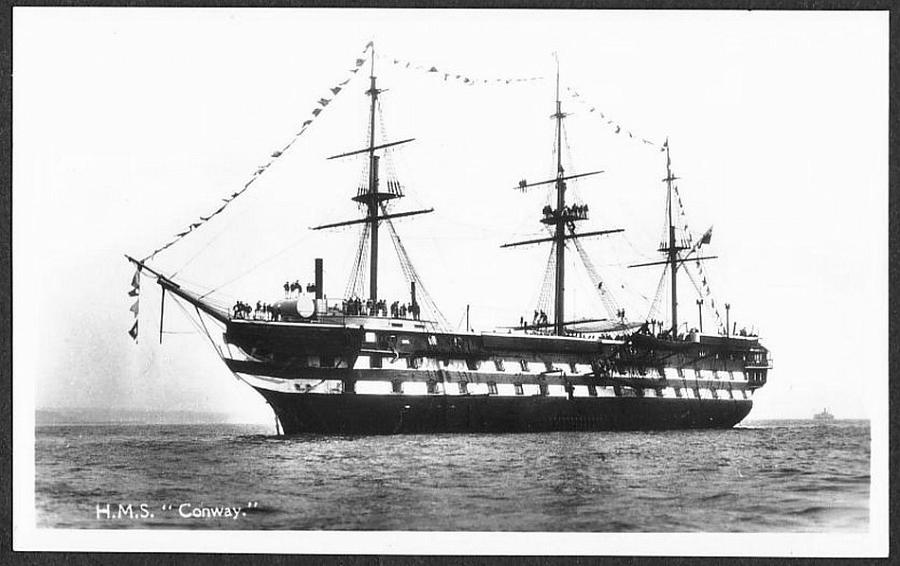
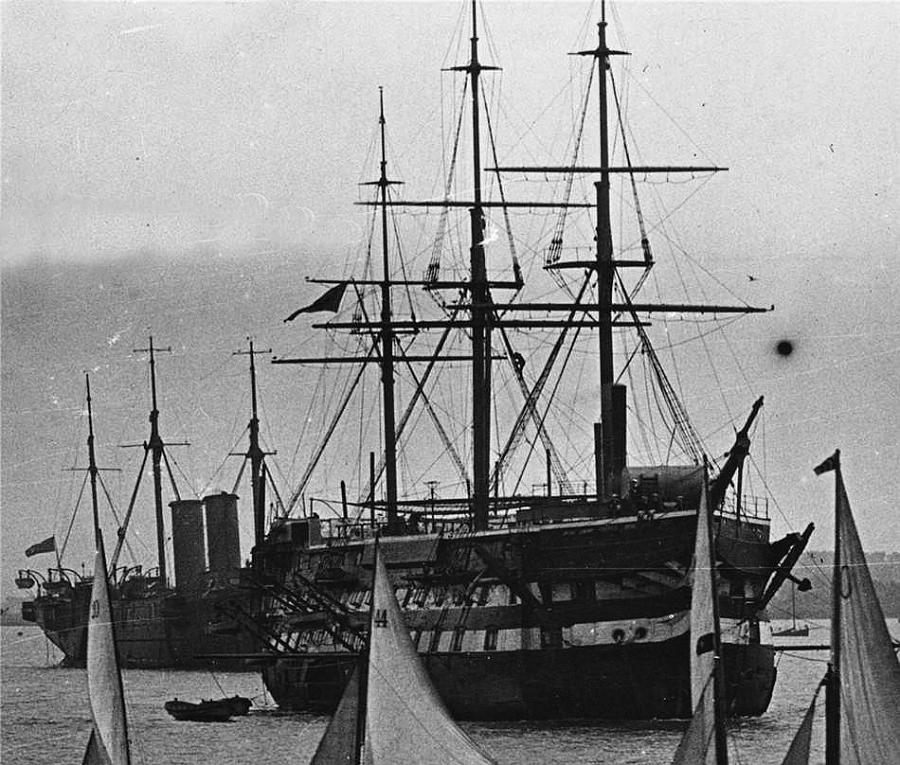
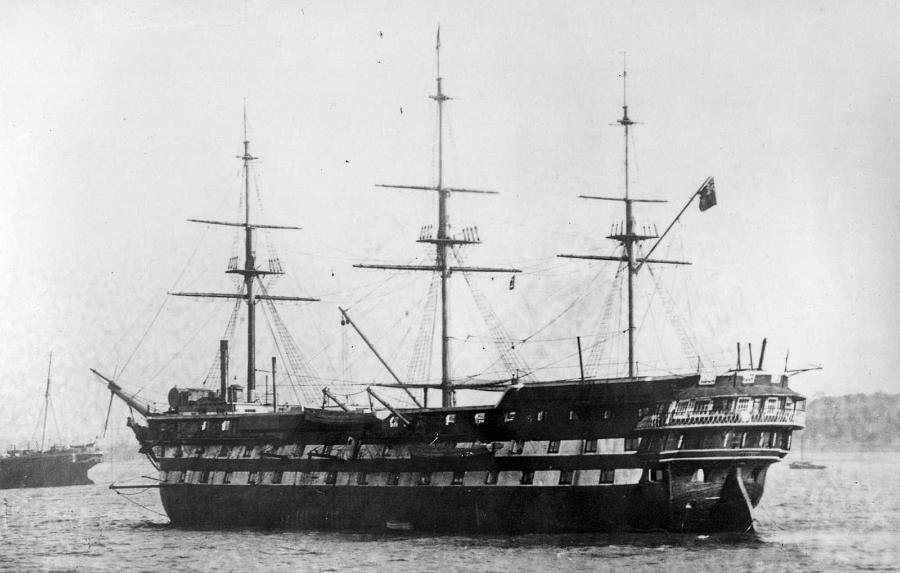
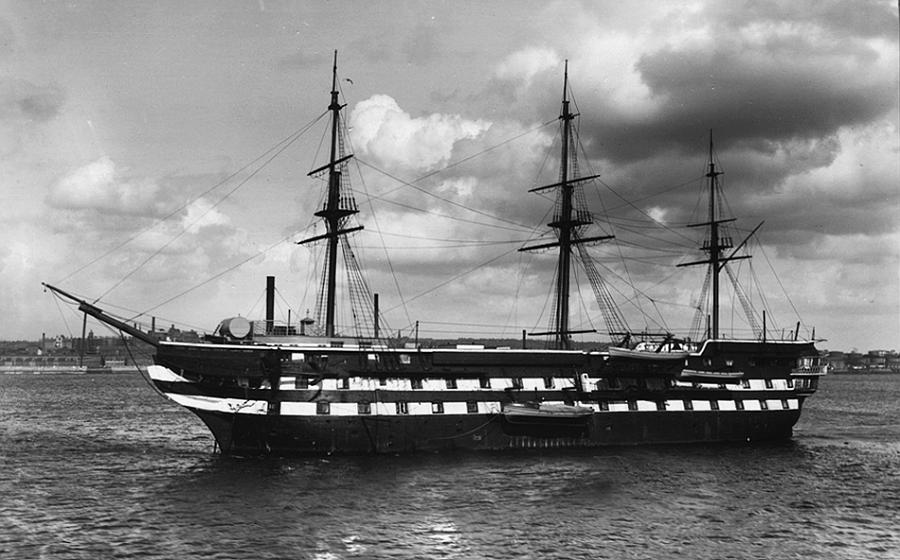
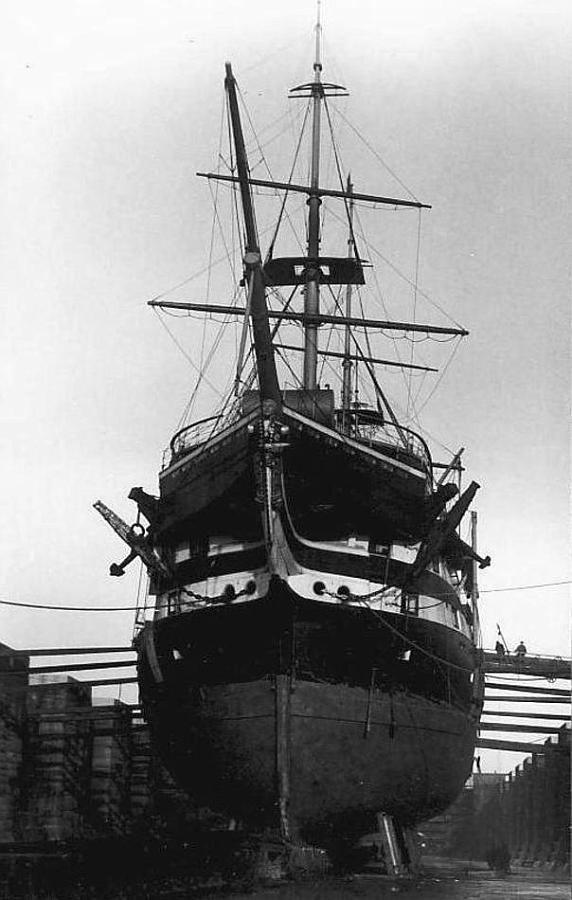
At the end of the 1940s there was a surge in demand for merchant navy
cadets. The ship did not have space for more cadets so the ship's
superintendent, Captain Goddard, started looking for space ashore with
playing fields and a shore establishment. He picked on Plas Newydd,
the stately home of the Marquess of Anglesey, a large part of which
had been vacated by the US Intelligence Corps at the end of the War.
This site seemed ideal, except that the seabed provided very poor
anchorage, so four five-ton anchors were sunk there. Only one problem
remained: could the ship be moved there in one piece? She would need
to be towed by tugs through a stretch of water between Anglesey and
the mainland, known as the "Swellies". This area, bounded by the two
Menai bridges (the Menai Suspension Bridge and Britannia Bridge), is
notorious for underwater shoals and dangerous, complex tidal streams
as well as a non-tidal current varied by the wind and atmospheric
pressure. Captain Goddard was proud of his experience as a
hydrographic surveyor, and having studied the problem, believed it was
possible.
After a false start the day before, the ship
was moved successfully on 13 April 1949, in spite of what was
obviously a great risk. Conway remains by far the deepest ship
ever to have passed through the Swellies. Her draft was 22 feet
(6.71 m) aft and the underwater clearances were marginal. The overhead
clearance under Menai Suspension Bridge, which is 100 feet (30.48 m)
above high water, was estimated to be three feet, all depending upon
the actual height of the tide at the time of passing through. "I was
glad when it was accomplished," Captain Goddard wrote. "It created a
great deal of interest amongst the North Wales seafaring fraternity
who had declared the undertaking to be a foolish one."
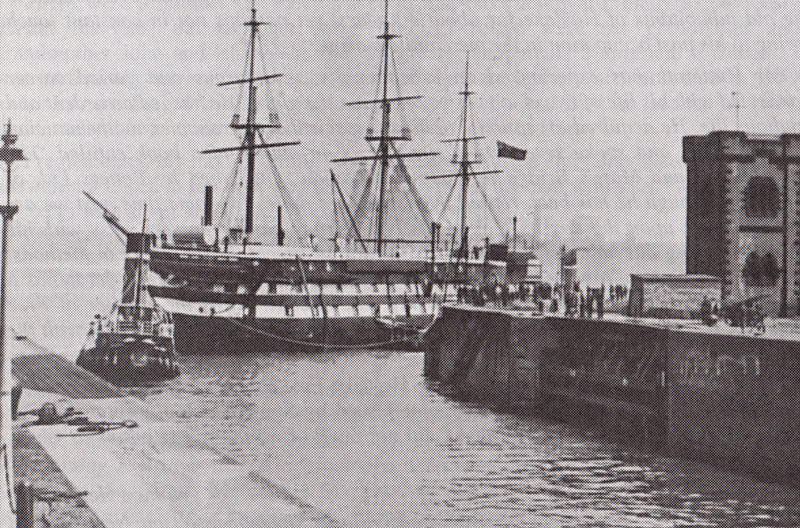
Moving
into Morpeth Dock for repairs in 1937
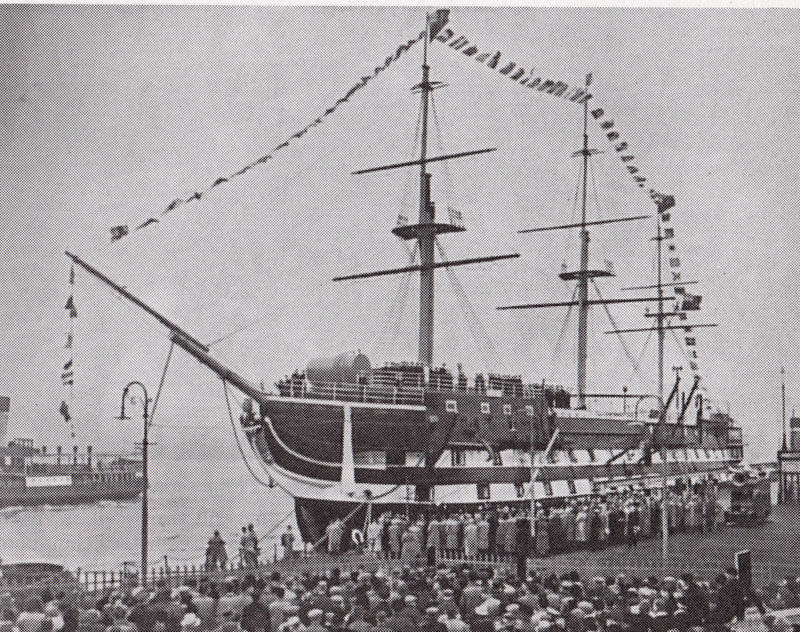
In 1938 Unveilling of new figurehead at the
Pier Head in 1938
Loss of the ship
The wreck of HMS Conway
This text is taken from an entry in Wikipedia
By 1953 another refit was due. This could not
be done locally so the ship had to be taken back to Birkenhead dry
dock, passing back through the Swellies once more. The operation
took place on 14 April 1953. There were the same two Liverpool tugs
which had shifted her several times before, Dongarth forward
and Minegarth aft. The new Captain Superintendent, Captain E
Hewitt was in command, with two Trinity House local pilots, Pilot R D
Jones (junior) aboard the head tug, Pilot R J Jones (senior) advising
Captain Hewitt, with Blue Funnel Liverpool Pilot James Miller
overseeing the towage.
High water at Liverpool that morning was
11:18, at a height of 32'10" and was the highest tide that year.
Lavers Almanac quotes high water at Menai Bridge as 28 minutes
before high water Liverpool. What is termed 'slack' in the Swellies is
actually a brief period of uneasy equilibrium between two opposing
flood streams which typically occurs 1 hour 42 minutes before local
high water, or at 09:08 on the morning of the move. Owing to the
strength of the southwest-going ebb, which runs at 8 knots during a
spring tide there is a confused complex tidal flow among the numerous
rocks and islets generating many powerful eddies. On a big tide in
particular it is vital for an outbound vessel to be through the
Swellies before the tide turns against her. It is therefore the local
practice to start an outward transit with the last of the
northeast-going flood 20 minutes before the 'slack', or at 08:48 on
the morning of the move. Captain Hewitt had worked with the Caernarvon
harbour master, Captain Rees Thomas, in preparing his plan, and had
several times made a passage of the Swellies in the Conway's
motor boat, checking his timings at 4 knots (7.4 km/h; 4.6 mph). He
also consulted Conway's
old log book for the timings of the previous transit, and had planned
to arrive at the bridge at 09:20.
The streams in the Menai Strait are affected
by winds outside in the Irish Sea. With a strong North or
North-westerly wind both the rate and duration of the Southwest-going
ebb are increased, and the Southwest-going ebb may begin quarter of an
hour earlier. (Admiralty Pilot vol 37; p 315; line21) The 0600
synoptic chart showed a stationary deep depression west of Norway with
a secondary Low in the North Sea, and a High steadily closing the west
coast of Ireland, which could be expected to result in an increasingly
strong NW'ly wind in the Irish Sea. But in the shelter of the Plas
Newydd mooring there was no indication of this. At 0800 as the wind
was being recorded in Conway's logbook as northerly force 1-2 (2 to 5
knots), only 13 miles away on station off Point Lynas it was being
recorded by the Liverpool Pilot boat as NW force 6 (22 - 27 knots)
(Subcom p4 line 7) and her noon entry was NW force 7, (28 - 33 knots)
(Beaufort wind scale) while during the morning Bidston Observatory was
recording gusts up to 49 knots (storm force 10).
The Investigating Subcommittee was later to
express its "surprise" that Captain Hewitt had left the Plas Newydd
mooring without a weather forecast, and "had no knowledge of the
stormy conditions prevailing at sea at the time Conway was to make the
passage" since it was local knowledge that in such weather
"abnormal conditions might be encountered." In addition to
the tide generated streams in the Menai Strait there is also a
non-tidal current, the Southwest Residual a dynamic reaction which
directly reflects wind stress in the Irish Sea. Dr Toby J Sherwin,
Estuarial research Menai Bridge, referring to a formula in Simpson
et al page 252, explained how the North-westerly mean wind speed
of 16 meters per second at sea that day would enhance the Residual by
15 cm per second, increasing the strength of the SW-going ebb at Plas
Newydd by 3 knots, "And quite obviously by a lot more than this in
the narrow sections of the Swellies."
Conway's logbook shows she left the mooring at 0822 and arrived at
Britannia Bridge at 0850, which was the locally recommended time for
starting the outward transit and Pilot Jones naturally advised keeping
her going with the last of the northeast-going flood tide behind her.
Instead Capt Hewitt had the ship brought up for half an hour to await
his 0920. The severe wind in the Irish Sea caused the stream in the
Strait to turn to the westward earlier which eliminated the brief
slack water period. Capt F J Durrant, Marine Manages of the towing
company, observed "The anticipated ten minute slack water did not
materialise. The ebb set in immediately the flood ended at 0920"
(Durrant p4 para 1) With the ship far too late and sensitive to the
adverse conditions Pilot Jones advised going back, instead the
logbook shows Capt.Hewitt passed the ship under Britannia Bridge
at 0923 even though the ebb tide was already setting against him which
was quite contrary to all local practice.
Only 17 minutes later, "At 0940 ..... the
forward tug "Dongarth" was towing at full speed against the tide but
making no further progress." By 1010am, 47 minutes after passing
under the bridge, the tow was still in much the same position having
made good only six tenths of a mile from the bridge, giving the tide
another half an hour to develop further, yet it was not until then
that Capt. Hewitt had the stern tug slipped and sent forward to assist
the head tug,
(photo) when "headway became slight but noticeable" By
1020, already a full hour into the ebb, the pilots had worked the ship
across the tide and into the eddy which Anglesey Pilot p17 para 106
states forms near the Anglesey shore close westward of the northern
pier of the Suspension Bridge,
(photo) and intended holding her there in the safety of this until
the strength of the tide had abated. Instead, with only 750 feet to go
to the bridge, Capt. Hewitt ordered that the ship be put back in the
channel and this was done. Almost immediately, at 1030, she was
suddenly caught by an eddy of overwhelming strength which drove the
ship ashore over The Platters. "This disastrous sheer occurred and
was concluded in a matter of seconds" which also shows the
position where the ship finished up, which was 'inked in' by Capt
Reece-Thomas who was Caernarfon Harbourmaster at the time) Contrasting
with the 18 minutes she had taken to complete the inbound transit, the
outbound ship had been 1 hour 7 minutes covering the 1200 yards from
Britannia Bridge where the pilot had advised going back.
After both tugs on full speed for ten minutes
had failed to make any impression they were instructed to stand bye at
Menai Bridge Pier for another attempt to re-float her on the evening
tide when there would be a better opportunity if the weather at sea
moderated. But a third tug, "Grassgarth", sent out at 1430 to
assist in towing her off was forced to put back to Liverpool through
stress of weather.
While her fore part planted firmly on the
shelving shore her stern was floating in 30 feet of water. As the tide
fell the stern lost its support
(photo) causing the ship to become severely hogged which opened up
her seams, and about her midship sections the height between decks was
reduced from over 6 feet (1.8 m) to less than 4 feet (1.2 m).
(photo) "Conditions on board were very bad with the after end
of the ship from the mainmast sagging downwards, and the continuous
sound of cracking, twisting, rending timber and rushing water below"
(photo) When the next tide made the stern failed to lift and the
ship flooded freely through her open seams. Being evident that further
attempts to tow the ship off would be to no purpose, the tugs were
discharged and left for Liverpool the following morning. Two days
after the grounding, in the evening of 16 April 1953, surveyors
declared "HMS Conway" a total constructive loss. The ship was
not insured.
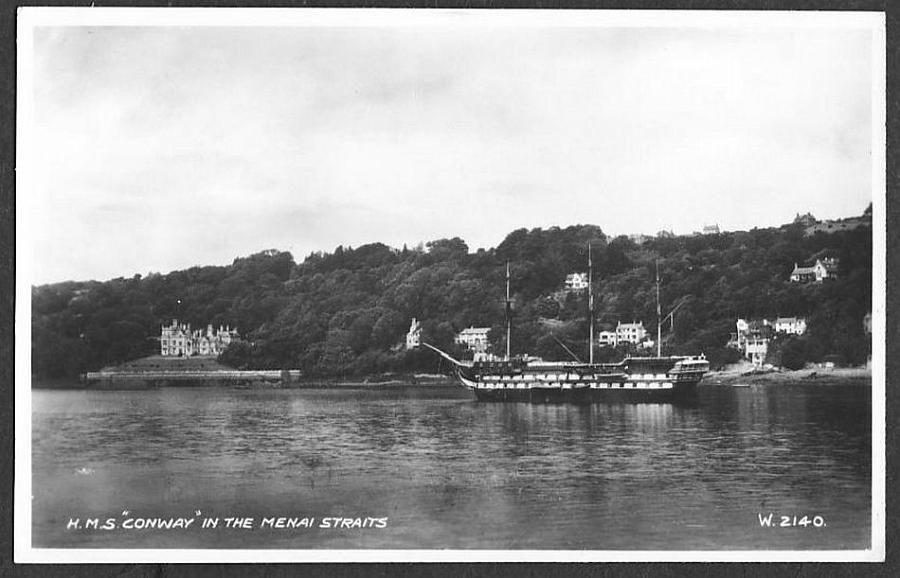
| Had the ship gone through at 0850
with the last of the tide behind her in keeping with local
practice, and as Pilot had advised, she would not have
encountered the unusually strong contrary ebb tide which
quickly overpowered the tugs to result in the loss.
Captain Hewitt had his reasons for delaying the ship until
0920, but "Conway" adequately demonstrated that
waiting for water in adverse conditions on a big tide was
not an option. If it was considered that the ship had
insufficient water at 0850, then as Pilot Jones recognised
the outward transit was impossible on such a day, but
pilot's advice was disregarded. |
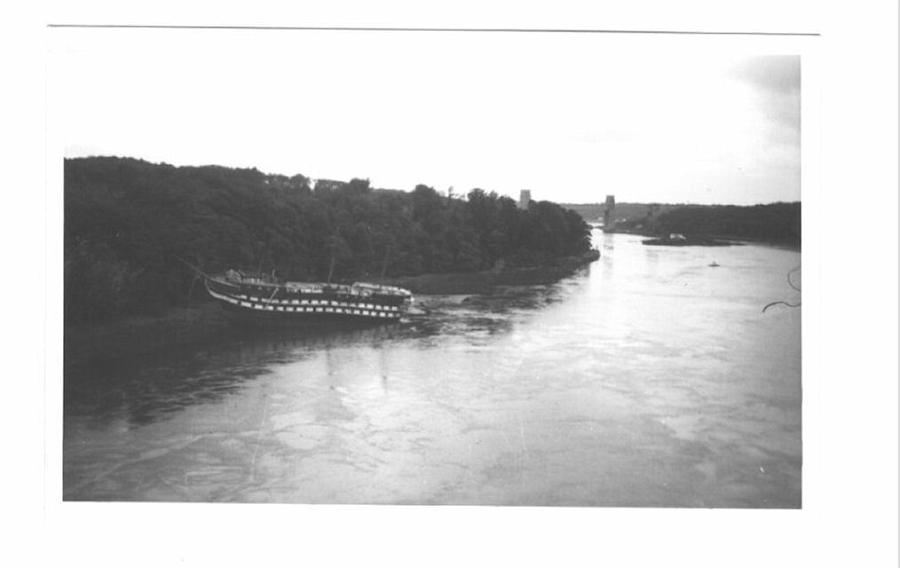
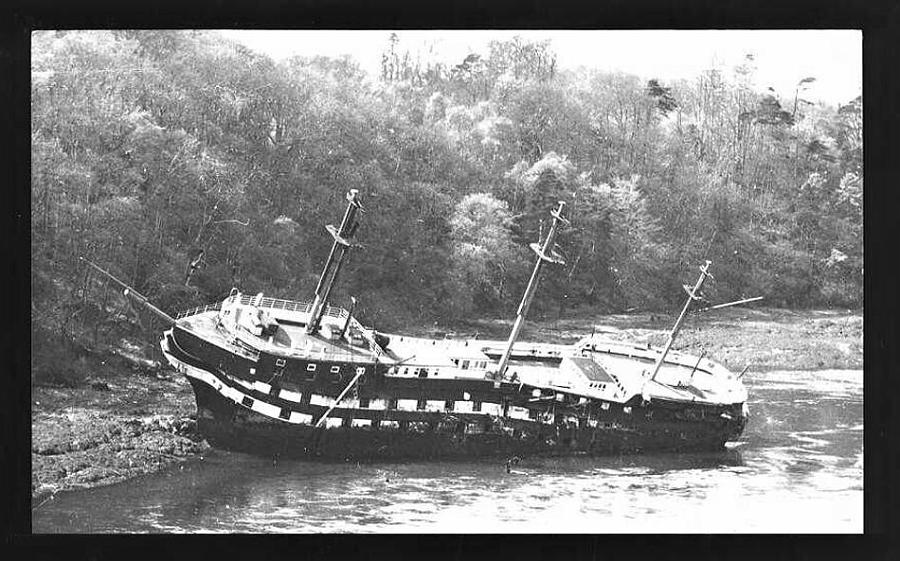
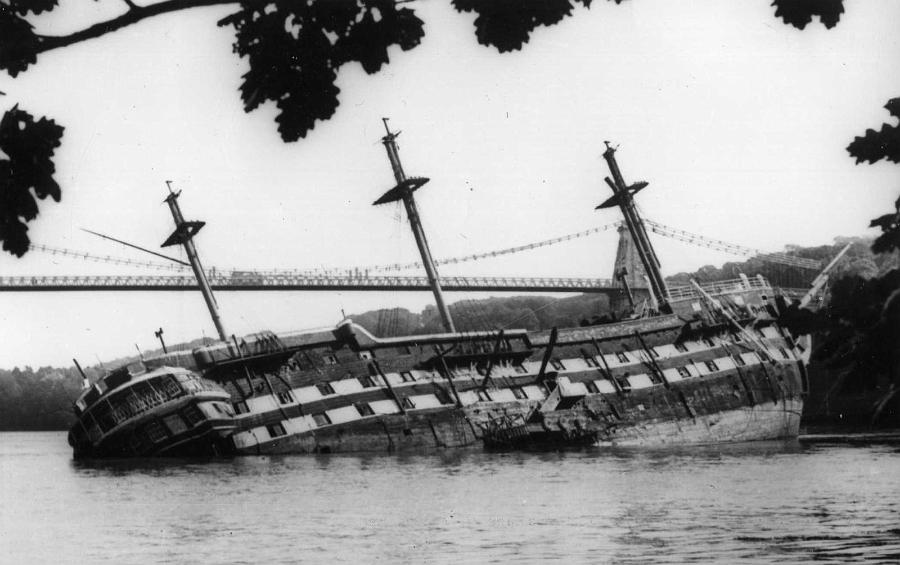
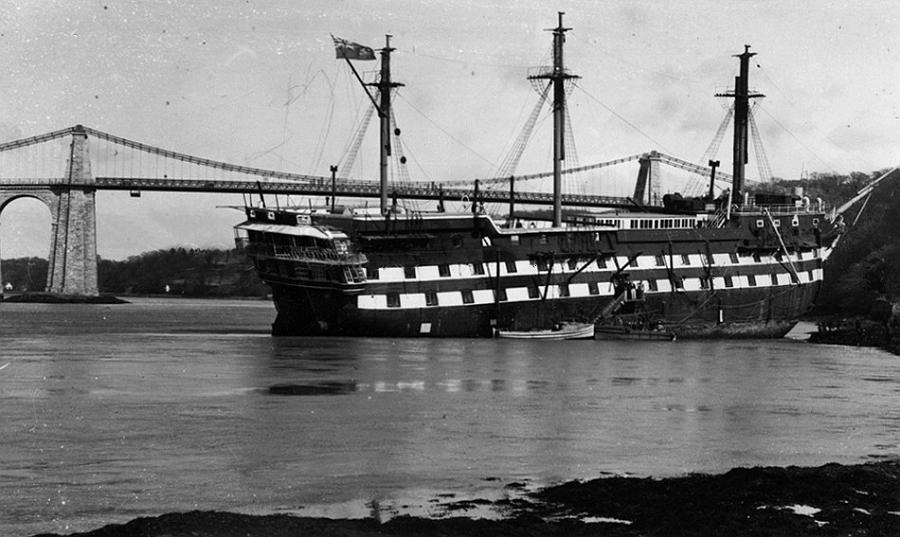
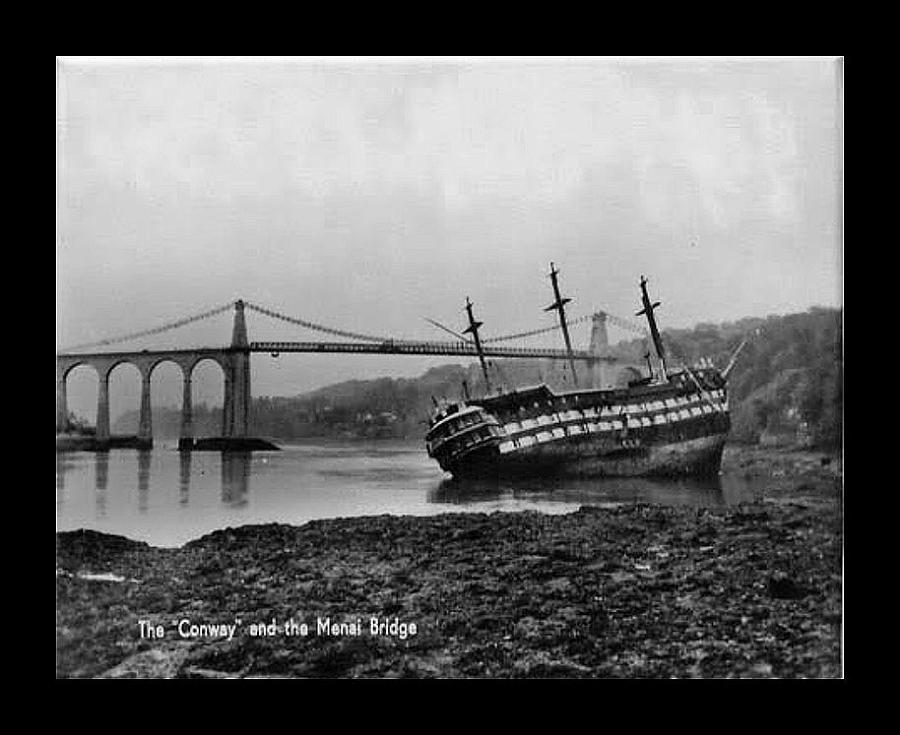
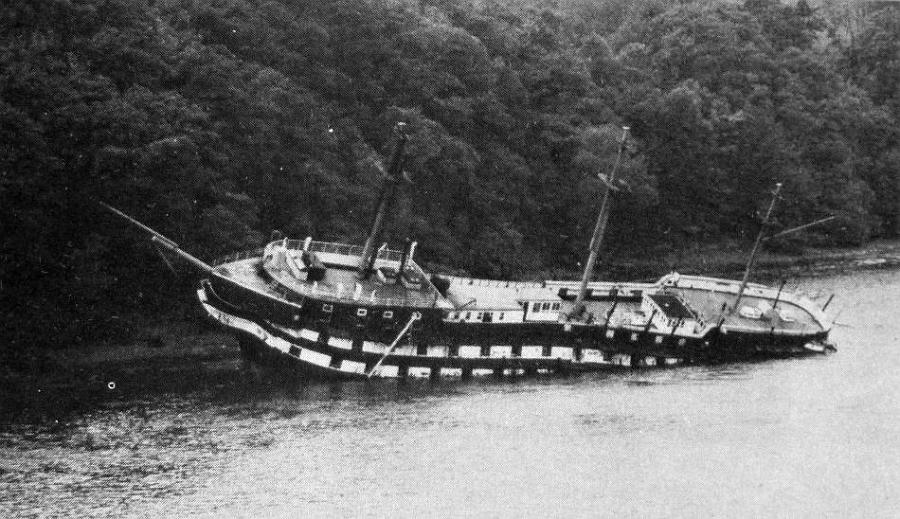
|








